Summary

Map of Israel
Israel is a parliamentary democracy in the Middle East. Freedom in the World has ranked Israel as the region’s only consistently “Free” country in its annual survey since 1973, but its scores have trended downward in recent years, now closer to “partly free.” While Israel’s multiparty system is highly diverse, including representation for minorities, Israel faces a multitude of challenges: an ongoing war and security threats; the rise of extremist political parties in governance; attempts to subvert the independent judiciary; corruption charges against a sitting prime minister; unequal treatment of a large Arab minority; and a military occupation of Palestinian territories lasting now nearly 60 years.
Israel declared its independence as a state on May 14, 1948 and established a national homeland for the Jewish people following the Holocaust. Independence was declared six months after the United Nations adopted a partition plan dividing the territory of Palestine, then under British mandate, into Jewish and Arab states. The plan was rejected by Arab states and Arab Palestinians, which led to a series of wars against Israel that threatened its existence. The first in 1948 resulted in the forced dislocation of 700,000 Arab Palestinians from Israeli territory. In the 1967 War, Israel occupied lands designated for a Palestinian state that until then were held under administration by Jordan and Egypt. Despite a 1993 agreement between Israel and the Palestinian Liberation Organization that instituted limited Palestinian autonomy over much of these territories, statehood remained unresolved. Since, Israel has expanded settlements in West Bank territory in violation of international law making a final settlement less likely.
Israel’s governance since 1948 largely alternated between two major left-wing and right-wing partes, Labor and Likud. But none achieved a majority vote and required coalitions with smaller religious and other parties or between themselves. Recent politics were unstable, with five elections from 2019 to 2022. A broad coalition — including for the first time an Arab Israeli party — formed a narrow majority in 2021 but the government lasted just one year. In November 2022, a majority right-wing government formed including extremist parties that seek annexation of the West Bank. The government's proposed law to limit the judiciary’s independence prompted national protests and a constitutional crisis.
On October 7, 2023, Israel suffered the largest mass killing of Jews since the Holocaust when it was attacked by Hamas, a terrorist group in control of the Gaza Strip, to Israel’s south. The attack and Israel’s subsequent war against Hamas has led to further political division. The government’s conduct of the war has been criticized internationally and domestically for the widespread destruction and large number of killed and displaced civilians and for not achieving clear military goals or the release of hostages taken by Hamas to Gaza (see Current Issues).
Israel is a small country on the Mediterranean Sea bordered by Egypt to the south and Jordan, Lebanon and Syria to the east and north. Excluding occupied territories (see History), Israel ranks 149th of 193 countries in area. Following emigration from Europe, the former Soviet Union, the Middle East and North Africa, the Jewish population grew from about one million at its founding to 7.5 million in 2023. Of the total population of about 10 million (UN estimate), 20 percent is Arab and 5 percent are non-Arab Muslims, Christians and Jewish immigrants not recognized as such by the Interior Ministry. The Jewish population consists of Ashkenazim (those of European descent) and Mizrahi (those of Mediterranean, Middle Eastern or other origin). The latter includes 160,000 Black Jews who emigrated from Ethiopia. Druze, who are conflated with the Arab Muslim population, practice a monotheistic, poly-confessional faith. About 750,000 Jewish citizens live in settlements built on the occupied territories of the West Bank, which has a population of 3.2 million Palestinians.
Despite its small size, Israel’s economy has grown to rank 28th in the world. Projected gross domestic product (GDP) for 2024 is $531 billion according to the International Monetary Fund. GDP per capita ranks 20th at $53,370.
History
Establishment of the State of Israel
The founding of Israel fulfilled the aims of the Zionist movement, which had sought to establish an autonomous state in the Jews' ancient homeland of Israel, also known as Palestine, since the late 19th century. While a majority of Jews had lived in diaspora, they had been a continuous presence in the region, including Palestine, since Roman occupation.
During World War I, Britain took control of Palestine from the collapsing Ottoman Empire. In 1917, the British government issued the Balfour Declaration, which expressed support for a Jewish national homeland in the area. British administration continued under a League of Nations mandate during the 1920s and ‘30s, in which time 350,000 Jews escaped persecution in Europe to Palestine. In this period, the Jewish population established political and military structures towards the goal of statehood, as well as the underlying basis for a national economy, including kibbutzim, or community farms, and the Histadrut labor federation).
The founding of Israel fulfilled the aims of the Zionist movement, which had sought to establish an autonomous state in the Jews' ancient homeland of Israel, also known as Palestine, since the late 19th century.
The Holocaust — Nazi Germany’s systematic murder of six million European Jews during World War II — brought a renewed urgency to establish a Jewish state despite objections by Arab countries. This was particularly the case due to increased immigration from Europe by displaced Jews denied entrance to other countries and desperate to find a safe haven.
Jewish militias, Arab military groups and British forces all were clashing when the UN General Assembly in November 1947 approved a plan to divide Palestine into Jewish and Arab states, with Jerusalem, at its center, as an internationally administered zone. Jewish leaders agreed to the plan and issued Israel’s Declaration of Independence on May 14, 1948 (see Resources and Multiparty System below). The United Kingdom’s mandate ended the next day. Israel’s capital, initially in Tel Aviv, was made Jerusalem in 1950 by the Knesset, although most countries maintained their embassies in Tel Aviv.
Military, Economic and Diplomatic Struggles
Arab countries and Palestinian leaders rejected the partition plan and the establishment of Israel, setting the stage for ongoing conflict. In its first 25 years of existence, Israel experienced three brief but intense wars with Arab neighbors that threatened Israel’s existence. These and a fourth conflict with Egypt in 1956 (the Suez Crisis) ended through UN and US diplomacy that sought to prevent a wider confrontation during the Cold War.
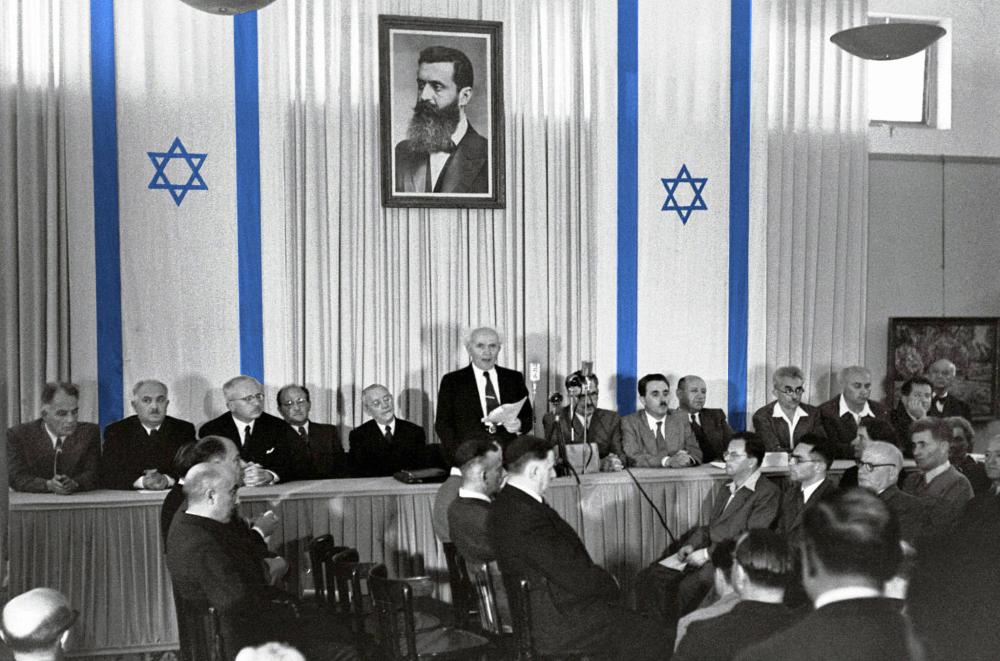
Ben Gurion, Israel’s first prime minister, reads the Declaration of Independence on May 14, 1948 under a portrait of Theodor Herzl, the founder of modern political Zionism.
In the first war in 1948, four Arab states invaded Israel after its declaration of statehood. Israel’s armed forces repelled the attacks and secured a UN-brokered armistice in January 1949. It left Egypt in administrative control of the Gaza Strip and Sinai and Transjordan (later Jordan) in control of the West Bank, the major areas the UN mandate mapped for a Palestinian state. Transjordan annexed its territory in 1950 without international recognition.
Over the course of both the civil and external wars, an estimated 700,000 Palestinians were displaced from their homes, often by force, in what Palestinians call the Nakba (or “catastrophe”). Most of those displaced were resettled in permanent refugee camps across the region.
Israeli militias had previously defeated Palestinian militias in a civil war-type conflict from 1947 to 1948. Over the course of both the civil and external wars, an estimated 700,000 Palestinians were displaced from their homes, often by force, in what Palestinians call the Nakba (or “catastrophe”). Most of those displaced were resettled in permanent refugee camps across the region while many who tried to return to their homes were prevented from doing so.
In the Six-Day War of 1967, Israel launched a pre-emptive strike before a planned Egyptian attack and seized the Sinai Peninsula and Gaza Strip. When Jordan and Syria also attacked, Israel occupied the West Bank, East Jerusalem and the Golan Heights (along Syria's border) prior to a cease-fire.

Israeli Defense and Egyptian Forces clash in the Six-Day war in 1967, when Israel militarily occupied the Sinai Desert, Golan Heights, West Bank, Gaza Strip and Jerusalem.
In 1973, Arab countries launched a surprise attack on the Jewish Holy Day of Yom Kippur. Israel suffered initial large losses but the Israel Defense Forces (IDF) rebuffed the advances, leading to a US-brokered cease-fire. Israel retained control of the occupied territories. In 1980, Israel annexed East Jerusalem and in 1981 it established de facto annexation of the Golan Heights, neither of which was recognized internationally.
After 1973, all of the Arab countries remained in states of war or hostility. Israel also confronted serious security challenges from a number of terrorist and militia groups. Supported by Arab states and the Soviet Union, these groups pledged to destroy Israel and drive Jews out of Palestine through terrorist or military campaigns. The groups included the Palestine Liberation Organization (PLO), also the main political organization of Palestinians, among several others.
The Camp David and Oslo Peace Accords
[Anwar Sadat's] initiative led to the signing in 1978 of the Camp David peace accords, brokered by US President Jimmy Carter. It was the first peace treaty between Israel and one of its Arab neighbors.
By 1977, President Anwar al-Sadat decided to end Egypt’s state of war with Israel and made a dramatic trip to Jerusalem to meet Israeli leaders. His initiative led to the signing in 1978 of the Camp David peace accords, brokered by US President Jimmy Carter. It was also the first major break of an Arab country with the Arab Boycott, a worldwide effort to bar trade with Israel put in place by the Arab League. As part of the Camp David agreement, the Sinai Peninsula was returned to Egypt. But region-wide peace efforts ended when Sadat was assassinated in 1979 by the Islamic Jihad terrorist group.
Terrorist actions were also directed at Israeli citizens by the Palestine Liberation Organization. As PLO guerrilla fighters increasingly struck civilian and military targets from southern Lebanon, the IDF invaded the country in 1982 to end the attacks. IDF forces left Lebanon only in 2000 but with its south still controlled by a Lebanese militia called Hezbollah (“Party of God”) backed by Iran and Syria.
[T]he 1993 Oslo Peace Accords . . . provided for PLO recognition of Israel and the PLO’s renunciation of terrorism. In exchange, Israel withdrew IDF forces from some areas of the West Bank and Gaza Strip and agreed to establishment of autonomy under a PLO-led Palestinian Authority.
In 1991, four years after a Palestinian intifada (“uprising” in Arabic) began against Israel’s military occupation, the PLO agreed to negotiations with Israel, which was then governed by the right-wing Likud party. These talks continued with a Labor government and led to the signing of the 1993 Oslo Peace Accords, which provided for PLO recognition of Israel and the PLO’s renunciation of terrorism. In exchange, Israel withdrew IDF forces from some areas of the West Bank and Gaza Strip and agreed to establishment of autonomy under a PLO-led Palestinian Authority. The terms envisioned an eventual Palestinian state through further negotiations. Afterwards, in 1994, King Hussein of Jordan signed a bilateral peace treaty with Israel.
Two Failed Agreements
Labor Prime Minister Yitzhak Rabin was assassinated in 1995 by a Jewish extremist opposed to the Oslo Accords. The Likud party, then led by Benjamin Netanyahu, then won early elections. In response to renewed terrorist violence, the government stopped further implementation of the Oslo Accords, however the Palestinian Authority maintained its status.

Prime Minister Yitzhak Rabin, left, shakes hands with Palestinian Liberation Organization leader Yasir Arafat at the signing of the Oslo Peace Accords, with President Bill Clinton center on September 13th, 1993. National Archives and Records Division.
Likud was defeated in 1999 elections for the Knesset. The Labor Party-led coalition government supported further peace negotiations. Prime Minister Ehud Barack agreed in 2000 to a comprehensive settlement brokered by US President Bill Clinton. But the PLO leader, Yasir Arafat, insisted on further negotiations. A second intifada broke out, waged mostly by Hamas and Islamic Jihad, more violent groups that rejected the Oslo Accords. A new Likud government headed by former General Ariel Sharon rejected any further negotiations. Over the next five years, terrorist attacks and suicide bombers killed nearly two thousand Israeli citizens, while counter-terrorism actions killed several thousand Palestinians. Attacks subsided after Israel erected a security barrier, much of it on occupied territory, and adopted harsh security measures infringing on Palestinian rights that are in force until today.
After Arafat’s death in 2004, Mahmoud Abbas was elected president of the Palestinian Authority. In 2005, Prime Minister Ariel Sharon changed course and unilaterally withdrew Israeli forces and Jewish settlements from the Gaza Strip in a new policy he called “security through disengagement.” Opposition to the policy within Likud led Sharon to create a new party, Kadima (“Forward” in Hebrew). Sharon suffered a debilitating stroke prior to the 2006 election, but Kadima still won a plurality of seats in the Knesset, Israel’s parliament, to form a new government. It continued the policy even after the more violent and rejectionist Hamas violently seized full control over the Gaza Strip from the PLO.
Sharon’s successor, Ehud Olmert, held secret talks with Mahmoud Abbas in 2007-08 based in part on an Arab peace initiative first put forward in 2002 but rejected by Ariel Sharon. Both leaders claimed later that they came near a final settlement on Palestinian statehood. Before concluding the agreement, however, Olmert resigned in 2008 due to corruption charges (see also Multiparty System below).
The Peace Process Halted
After elections held in 2009, the peace negotiations ended. Neither Benjamin Netanyahu, returning to power as prime minister, nor Palestinian Authority President Mahmoud Abbas would meet the other’s preconditions. (Likud demanded recognition of Israel as a Jewish state. The Palestinian Authority demanded a halt to Israeli settlements on the West Bank.) A US initiative led to renewed talks in August 2013 but they broke down by 2014.
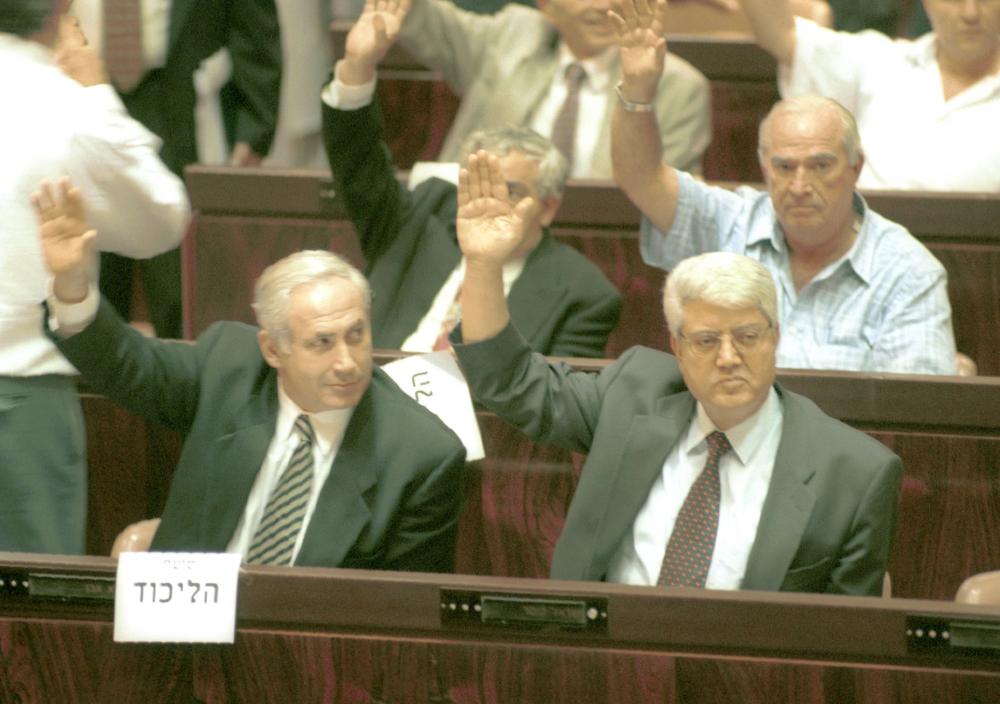
Benjamin Netanyahu voting in 1996 in the Knesset on the creation of the 27th Israeli Government following the assassination of Yitzhak Rabin. Creative Commons License. Photo by Gideon Markovitz of the Israel Press and Photo Agency.
When the United States formally recognized Jerusalem as Israel’s capital in 2017 under the Trump Administration, the Palestinian Authority broke ties with the U.S. and rejected it as a mediator for negotiations. A separate “quartet” group (the UN, US, EU and Russian Federation) proposed a “road map” for peace negotiations that neither side accepted.
Netanyahu has led Israel as Prime Minister for most of this period (see also Multiparty System below). In that time, he has resisted a two-state solution on grounds that a Palestinian state could not guarantee Israel’s security and that Jewish Israelis have a right to settle in Palestinian territory as part of Biblical (or Greater) Israel. Mahmoud Abbas has remained president of the Palestinian Authority, which remains in formal administrative control over the West Bank, without holding elections since 2009. He has called for international pressure on Israel to negotiate on Palestinian statehood and the “right to return” for descendants of those displaced in 1947–48.
Settlements are an increasing impediment to any peace process. After Israel occupied East Jerusalem, the West Bank and Gaza Strip in 1967, Labor governments approved settlements by Israeli citizens in border areas, mostly around Jerusalem, on grounds of security. Likud-led governments annexed East Jerusalem in 1980 and authorized settlements beyond border areas. Netanyahu’s governments have expanded settlements much farther into the West Bank as settler parties played larger roles in government (see below).
Military and Security Threats
Israel continued to face military and terrorist threats.
Despite an armistice reached in 2006, the Lebanese Shiite group Hezbollah has periodically launched missile and armed attacks near the border. Also, Hamas launched repeated rocket attacks against Israel from the Gaza Strip, the most serious being in 2014 when 10,000 rockets were fired at Israeli civilian centers. Most were repulsed by an air defense system called Iron Dome. Retaliatory campaigns were aimed at Hamas military sites. Because there are largely embedded in civilian areas, the strikes resulted in large civilian casualties. There were intermittent rocket attacks since.
Major Arab neighbors like Iran and Syria remain in states of hostility or war with Israel. The extremist groups Hezbollah, Hamas and Islamic Jihad, armed by Iran, remain pledged to destroy Israel. Iran continues to pursue nuclear weapons capability and its leaders repeatedly threaten to destroy Israel. However, agreements brokered by the United States in 2020 known as the Abraham Accords expanded normalization of relations and trade ties with Israel by Bahrain, the United Arab Emirates, Sudan and Morocco, while diplomatic efforts continue for recognition by Saudi Arabia, even during the most recent war against Hamas in Gaza (see Current Issues below).
Multiparty System
Throughout numerous wars, acts of terrorism, political crises and many internal and social conflicts, Israel has remained a multi-party democracy ─ the only such example in the Middle East. But the country faces serious challenges to its democratic system due to a fracturing of political parties, corruption charges against a sitting prime minister, extremist and exclusionist parties in governance, the denial of full citizenship rights to Arab Israelis and the undermining of the country’s democratic character arising from its military occupation of Palestinian territories.
Throughout numerous wars, acts of terrorism, political crises and many internal and social conflicts, Israel has remained a multi-party democracy ─ the only such example in the Middle East.
Freedom of association, assembly, speech and religion are largely respected within Israel, including for minority citizens. Social freedoms are generally guaranteed but with a number of restrictions for women, gay partners and mixed religious relationships due to oversight of personal status issues by religious courts. Israel’s media are mostly independent and represent diverse political views although there is increased partisan control of both private and public media. Internet access is unhindered.
The rule of law until now functioned through an independent judiciary to limit the abuse of state power and sometimes acted against discriminatory policies and land confiscations within Israel and occupied territories. However, a political crisis arose over attempts by the current government to control the judiciary and limit its interference in government policies (see Current Issues below). Freedom House still ranks Israel as Free, but its scores declined in recent years to the lower end of the Free category.
Israel’s Political System
Israel has a parliamentary system with a 120-seat unicameral legislature called the Knesset. It elects a president as head-of-state for a single seven-year term. While not invested with large powers, the president often acts as a mediator in political disputes.
[Israel] faces serious challenges to its democratic system due to a fracturing of political parties, corruption charges against a sitting prime minister, the denial of full citizenship rights to Arab Israelis, extremist and exclusionist parties in governance and the undermining of the country’s democratic character arising from its military occupation of Palestinian territories.
Prime ministers were directly elected for a brief period between 1996 and 2001. Otherwise, the president has held the formal authority to nominate a prime minister to form a government. Usually, this is the head of the leading party in elections, but this depends on being able to form a majority coalition. Executive power is exercised by the prime minister and the cabinet, who are collectively approved by parliament. The Knesset then has power to remove a cabinet member singularly or the government entirely in no confidence votes.
Members of the Knesset are elected to four-year terms, but new elections are called when a government loses a vote of confidence and parties are unable to form a new majority coalition. In elections, voters choose among national party or coalition bloc lists according to a proportional system. The threshold for entering parliament was raised in 2014 from 2 to 3.25 percent.
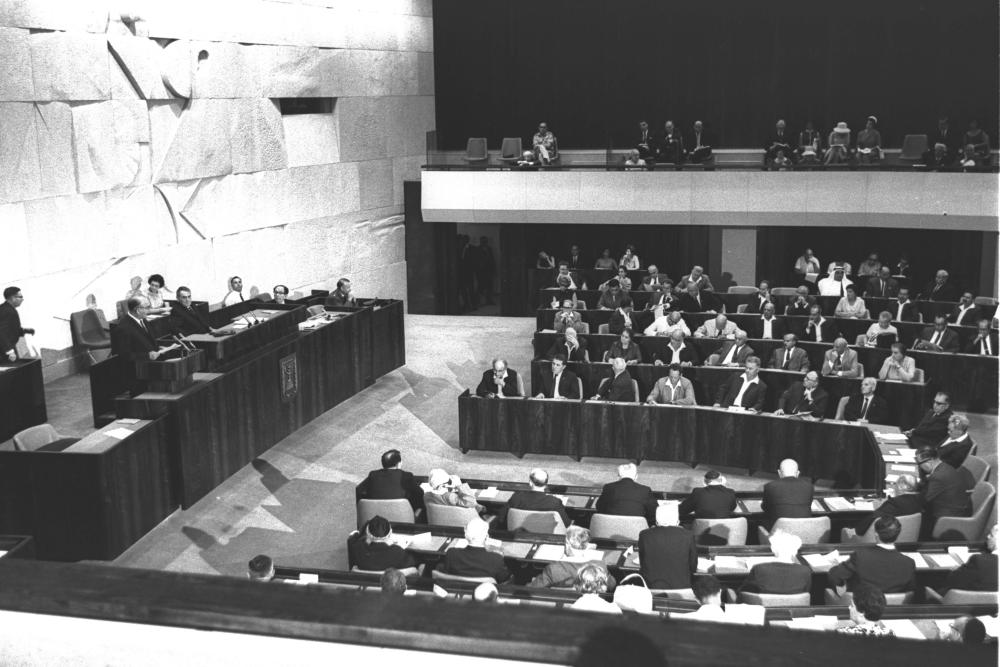
Israel has a parliamentary system with a 120-member Knesset. Israel’s third Prime Minister, Levi Eshkol, a founder of the Labor Party, speaks to the first session of the 7th Knesset in 1969 at its new building in Jerusalem.
From 1949 to 2022, twenty-five elections have been held with between ten and fifteen parties represented in the Knesset. Since 2000, this diverse multi-party system has led to many new parties and more recently to unstable coalitions.
Israel’s politics were dominated by two main ideological parties after independence (Labor on the left and Likud on the right). This reflected the two main currents of the Zionist movement (with Likud representing Revisionist Zionism). At the same time, many other major and smaller parties, including personality-based, religious and Arab-Israeli parties, have been a constant presence in Israeli politics.
From 1949 to 2022, twenty-five elections have been held with between ten and fifteen parties represented in the Knesset. Since 2000, this diverse multi-party system has led to many new parties and more recently to unstable coalitions, creating political instability (see Current Issues).
Israeli Elections, Parties and Coalitions: A Brief History
From 1948 to 1977, Israel was governed by a succession of coalition governments led and dominated by the left Labor Party and its socialist antecedents. These generally represented the dominant Ashkenazi population that had emigrated to Palestine from Europe. The right-wing Likud party, which had larger support from Mizrahi Jews who immigrated later from the Middle East and North Africa, formed a government for the first time in 1977. Afterwards, there was an alternation of Likud-led, Labor-led, and Likud-Labor unity governments.
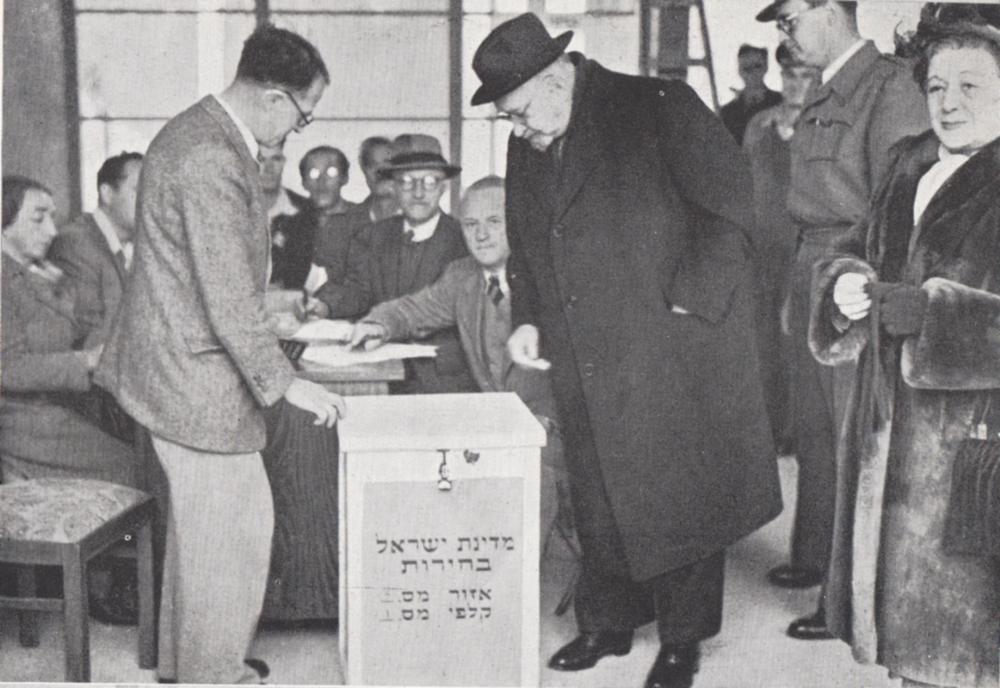
Israel has had 25 multiparty elections over its 75-year history. Israel’s first president, Chaim Weizman (right), votes in the 1952 parliamentary elections.
Direct elections for prime minister were held from 1996 to 2001. Likud’s Benjamin Netanyahu won the first election; Labor leader Ehud Barak won the second in 1999; and a new Likud leader, Ariel Sharon, won in 2001. Direct elections were abandoned thereafter.
After elections held in 2003, a new dynamic emerged. At first, Sharon formed a Likud-led coalition with four right-wing secular and religious parties. But his leadership was challenged due to his policy of “security through disengagement” and the forced withdrawal of settlements, together with the IDF, from the Gaza Strip (see above). Sharon, still highly popular, left Likud in 2005 and created a new centrist party, Kadima (Forward), to carry out his new policy. Leading members of both Likud and Labor left their parties to join.
Sharon had a debilitating stroke prior to the 2006 election, but Kadima still won an unprecedented 22 percent for a new party. Now led by Sharon’s deputy, Ehud Olmert, it formed a center-left coalition with Labor and smaller parties.
In 2008, Olmert resigned as prime minister after being indicted for corruption involving property deals that he oversaw as Mayor of Jerusalem. He was the first Israeli prime minister to be indicted or convicted on criminal charges.
In 2008, Olmert resigned as prime minister after being indicted for corruption involving property deals that he oversaw as Mayor of Jerusalem. He was the first Israeli prime minister to be indicted or convicted on criminal charges. The Supreme Court overturned the most serious bribery conviction in 2015 on procedural grounds, but Olmert served 18 months in prison on other charges.
Tzipi Livni, who had led peace negotiations as foreign minister in 2007-08 (see also above), headed the caretaker government as prime minister and won a narrow second victory for Kadima over Likud in 2009 elections (each won 22 percent of the vote). But an extremist party, Yisrael Beiteinu (Our Home), calling for expulsion of the Arab population from Israel, came in third (12 percent), while Labor had its worst showing in its history (10 percent).
The Role of Smaller Parties
Throughout Israel's history, smaller parties had a large role in forming governments and tended to complicate the politics and policies of coalitions by requiring the major parties to satisfy specific special interests or policies.
Throughout Israel's history, smaller parties had a large role in forming governments and tended to complicate the politics and policies of coalitions by requiring the major parties to satisfy specific special interests or policies. Two Orthodox religious parties, United Torah Judaism and Shas, are the longest-lasting, usually netting 10 to 15 percent of the vote. They receive concessions to what is called the “religious establishment,” such as Sabbath laws, subsidies for religious schools and military exemption for religious study, in exchange for joining either left- or right-led coalitions.
More recently, nationalist parties favoring expansion of settlements in occupied territories and rejecting a two-state solution became linchpins to right-led coalition governments. Personality-based and splinter parties on the model of Kadima (see above) created a new centrist bloc that supported ending concessions to religious and nationalist parties. Meanwhile, the two left parties, Labor and a small peace party, Meretz, declined precipitously.

Arab-Israeli parties have regular representation in the Knesset. Aymen Odeh headed a Joint List coalition of three Arab parties, which won an unprecedented third place in 2015 elections. Creative Commons License. Photo by Anan Maalouf.
Arab-Israeli parties were constricted at first due to martial law authority governing Arab-Israeli areas in Israel until 1966. In recent decades, three Arab-Israeli parties (United Arab List, Hadash and Balad) emerged to have strong, if not fully proportional, representation, netting from 8 to 13 seats. But these parties were not included in governing coalitions due to their general opposition to Zionism and public sympathy for the political aspirations of Palestinians in occupied territories. They thus had little influence on national policy until recently, when new parties emerged focused on representing Palestinian interests within Israel (see Current Issues below).
Attempts by Jewish politicians to ban Arab Israeli parties were rebuffed by the government's legal adviser. When a law allowing such bans passed the Knesset, it was rejected by the Supreme Court, which also acted to reinstate a leader of one party to the Knesset after being expelled.
The Netanyahu Era
After its narrow victory in 2009 elections, Kadima failed to put together a majority coalition. Benjamin Netanyahu. as leader of Likud, returned to power by forming a government with the fourth-place Labor party. It was the first of many narrow-majority governments Netanyahu would lead as prime minister over the next 15 years.
The Likud-Labor coalition lasted a full term. But the 2013 elections were as fractured as the previous election. Likud led with 23 percent of the vote while the Labor Party, further divided by its participation in a Likud-led government, came in third (11 percent). A new centrist party, Yesh Atid (“There Is a Future”), headed by a popular radio personality, won 15 percent. A new party of former Kadima and Labor leaders won 5 percent. The pro-settler Jewish Home and the two religious parties together won 23 percent.
Netanyahu formed an unlikely coalition joining Likud with the two centrist parties and the secular but nationalist Jewish Home. Religious parties were put in opposition for the first time since 1948, allowing the government to eliminate the unpopular religious exemption for military service. But the parties had such divergent views on the peace process that the coalition broke apart after US-brokered peace negotiations failed in 2014 (see History above).
In the early elections held in March 2015, Likud equaled its previous result (23 percent). A new left-Labor coalition called Zionist Union received 18.5 percent, while Yesh Atid split the centrist vote with a new party, Kulanu (“All of Us”), each getting 8 percent. For the first time, the Arab-Israeli parties united in a Joint List on a platform to address community needs within Israel and came in an unprecedented third place (10.5 percent).
A Tumultuous Period
Netanyahu had campaigned on a chauvinist platform and now led a right-wing majority coalition that included the two nationalist parties and two religious parties, which were able to restore the religious exemption for military service. The coalition lasted a full term but it was an uneasy period. There was increased violence by extremist settlers against Palestinians on the West Bank and violence by Palestinians against the military occupation.
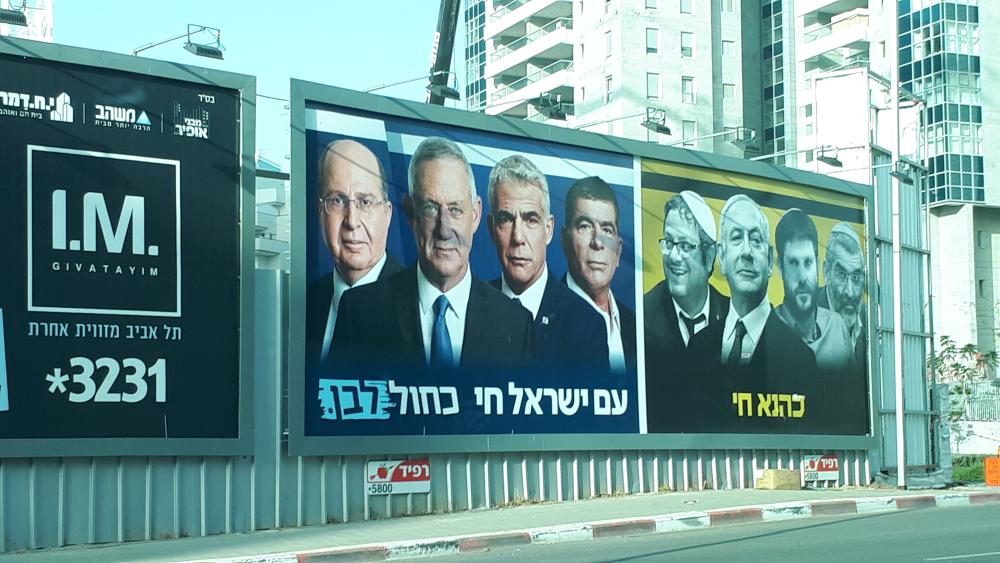
In a period of political instability, Israel had five elections within a period of four years. An election poster in April 2019 pitting Likud (right) against the Blue and White coalition (left). Creative Commons License.
Most notable, however, was adoption of a new Basic Law in 2018, “Israel-the Nation State of the Jewish People.” Israel does not have a formal constitution. Its foundational law consists of the Declaration of Independence (see Resources) and what are called Basic Laws (13 thus far), which may be passed by majority but traditionally were passed with supermajority or consensus support.
The new law, passed by a slim majority (62-55), formalizes a second-class citizenship for Arab Israelis and appears to lay the basis for further annexation of occupied territory. While the Declaration of Independence clearly defines Israel as the homeland of the Jewish people, the new Nation State law conflicts with the Declaration by not affirming equal citizenship for Arabs and by making Arabic a non-official language. (Netanyahu stated the purpose of the bill was to affirm explicitly that “Israel is not a state of all its citizens.”) The law also asserts that “the development of Jewish settlement [is] a national value.” This, too, contradicts the Declaration’s commitment to the Charter of the United Nations and the original UN Resolution’s establishment of two states with specific, delineated territories.
Political Instability
In the fall of 2018 when Israel’s Attorney General, who is appointed to a fixed six-year term, announced an investigation of Prime Minister Netanyahu for corruption. The announcement led to a vote of no confidence in December 2018 and the fall of the government. What followed was an unprecedented five elections over a four-year period from 2019 to 2022.
The first two elections, held in April and September 2019, were inconclusive. The elections pitted Likud and its allies against three centrist parties uniting in an anti-Netanyahu coalition called Blue and White (the colors of the Israeli flag). Since no government majority was able to form, Netanyahu remained as prime minister with a caretaker government. In November 2019, the Attorney General formally indicted Netanyahu on charges of receiving illegal gifts and using government influence for positive media coverage. Unlike Ehud Olmert in 2008 (see above), Netanyahu refused to resign. Instead, he accused the Attorney General of being part of a “deep state” conspiring against him.
In the fall of 2018 when Israel’s Attorney General, who is appointed to a fixed six-year term, announced an investigation of Prime Minister Netanyahu for corruption. The announcement led to a vote of no confidence in December 2018 and the fall of the government. What followed was an unprecedented five elections over a four-year period from 2019 to 2022.
After a third inconclusive election in March 2020, one leader in the Blue and White coalition, the former Likud defense minister Benny Gantz, agreed to join a government due to the Covid-19 crisis. But the government fell after six months when it could not agree to a budget. With concerns rising over the prime minister’s efforts to maintain power to ward off prosecution, a broad anti-Netanyahu alliance arose for the election held in March 2021. The leaders of Yesh Atid and a nationalist party formed a one-seat majority coalition with two other centrist parties, the Labor-Meretz coalition and, for the first time, an Arab-Israeli party, Ra’am. The coalition government passed a national budget for the first time in four years, including new investments in Arab-Israeli communities. But it, too, fell after eighteen months when Ra’am’s leader withdrew over the nationalist party’s insistence on approving new West Bank settlements.
A fifth election held in November 2022 resulted in a more stable government but an even greater period of instability, as described below.
Current Issues
Since 1996, Israel’s politics have been dominated by Benjamin Netanyahu and the Likud Party, which defined itself by its free market policies, a hardline security platform, opposition to a two-state solution to the Israeli-Palestinian conflict, expansion of West Bank settlements and increasing chauvinism towards Arab Israelis. Netanyahu has been prime minister for a total of eighteen years, longer than anyone in Israel’s history. Since 2009, his leadership was interrupted only once for an eighteen-month period by a broad anti-Netanyahu alliance in 2021-22 (see above). The governments he led adopted more nationalist and authoritarian practices over time as he allied more with far-right and extremist parties.
Since 1996, Israel’s politics have been dominated by Benjamin Netanyahu and the Likud Party, which defined itself by its free market policies, a hardline security platform, opposition to a two-state solution to the Israeli-Palestinian conflict, expansion of West Bank settlements and increasing chauvinism towards Arab Israelis.
The November 2022 election, the fifth within four years and the 25th in Israel’s 75 years of existence, resulted in a plurality for Likud, again with 23 percent of the vote (32 of 120 seats). The Religious Zionist Party, a far-right settler party, ran in alliance with another extremist party, Jewish Power, to get 11 percent (14 seats). The two traditional religious parties garnered 14 percent total (18 seats). The centrist bloc split, with Yesh Atid (There Is A Future) and Benny Gantz’s National Unity Party getting 18 and 9 percent, respectively. Two Arab-Israeli parties, Hadash -Ta’al, running on a joint list, and Ra’am each entered parliament with 4 percent. Labor barely gained seats, also at 4 percent.
Netanyahu formed a 64-seat majority with the far-right nationalist alliance and the increasingly assertive religious parties. Early actions indicated the new government’s extremist nature. Jewish Power leader Itamar Ben-Gvir, who was rejected for military service due to his support for political violence, was named minister of national security. He immediately instigated a violent confrontation with Muslims over the long-standing but unresolved issue of Jewish prayer at the Al Aqsa Mosque in Jerusalem, also the site of the Second Temple destroyed in 70 CE. The leader of the Religious Zionist Party, Bezalel Smotrich, was named Finance Minister. Early in his tenure, he called for a West Bank village’s “eradication” after violence incited by Jewish settlers against Palestinians.
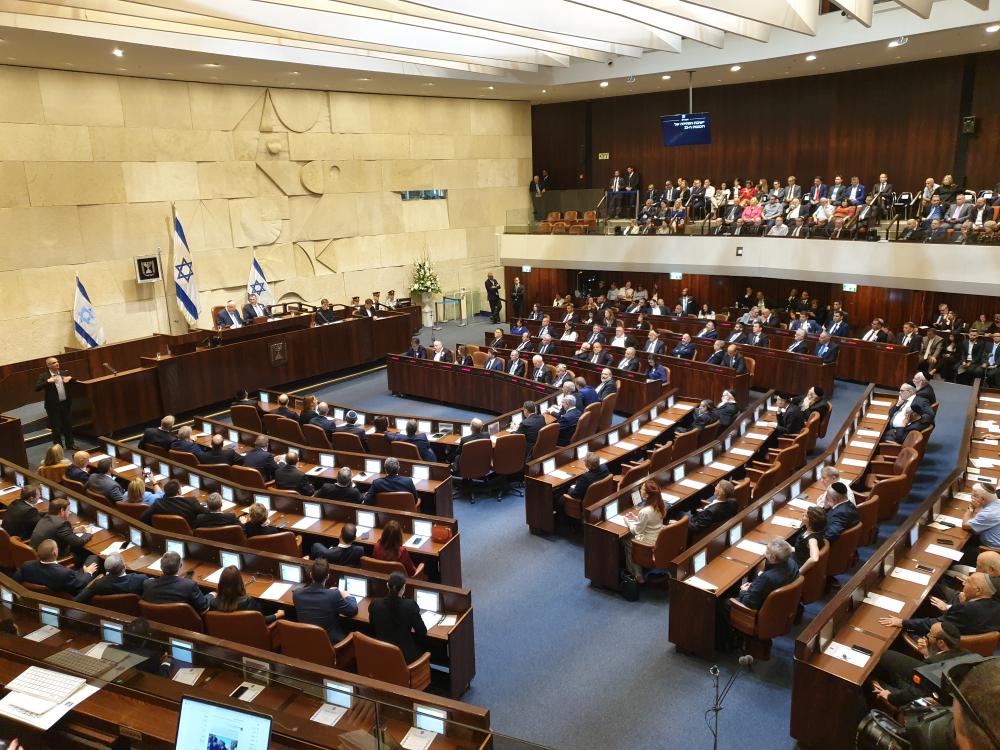
A Meeting of the 22nd Israeli Knesset, 2019 following a second inconclusive election. Benjamin Netanyahu remained acting prime minister when no majority coalition could be formed. Photo by Roman Yanushevsky.
Netanyahu Tests Israel’s Democracy
In creating the far-right coalition, Prime Minister Netanyahu pledged to push for a judiciary reform law. This would give the government greater control over judicial nominations, grant the Knesset power to overrule Supreme Court decisions by a simple majority and restrict the basis for judicial review.
Given Israel’s lack of a constitution, the proposed law would effectively remove any check on a Knesset majority’s power. This is particularly significant for Arab Israeli citizens and Palestinians in the West Bank and East Jerusalem since the Supreme Court is the last recourse against discriminatory actions and seizures of property. (An impetus for “judiciary reform” was a 2015 Supreme Court decision ordering the dismantlement of unauthorized settlements.
But the ”reform” bill was also widely seen by Jewish citizens as a power grab by Benjamin Netanyahu and an attempt to manipulate the judiciary while still facing investigation and trial for corruption. A large majority in polls opposed the reform bill as a threat to Israel’s democracy giving unchecked power to temporary electoral majorities. Massive demonstrations against the bill took place across the country weekly from January to April 2023. When Netanyahu dismissed his defense minister for voicing opposition to the bill as a threat to the nation’s national security, 500,000 people protested nationwide. Generals and security officials warned of serious division within the armed forces.

Likud joined with the extremist Jewish Strength party, led by Itamar Ben Gvir, in 2022 elections. A campaign poster reads “It’s Only With Ben Gvir That You Get Bibi” (the diminutive of Benjamin Netanyahu). Shutterstock. Photo by: Marie Selissky.
Under such public pressure, Netanyahu reversed the defense minister’s dismissal and delayed the law’s consideration. After a three month pause, however, Netanyahu broke negotiations with opposition parties and ordered the reform bill taken up in parts. The first part barred the “reasonableness standard” as a basis for judicial review. The standard is common in the United Kingdom and other countries with parliamentary systems as a judicial check for reviewing the legality or constitutionality of government actions. (An example was its last application by Israel’s Supreme Court. It ruled Netanyahu’s choice for Finance Minister as unreasonable on the grounds that the proposed minister, the Shas religious party leader, had just been convicted of tax evasion for a second time.)
The first part of the law passed the Knesset despite ongoing protests and pledges by reserves to resign from military service, threats of a general strike and appeals by all living former prime ministers, defense ministers and intelligence chiefs against the law’s passage. Prime Minister Netanyahu suspended further consideration of the “reform” following the October 7 attack on Israel by Hamas and the launching of a full-scale war against Hamas (see below). In January 2024, the Supreme Court struck down the law.
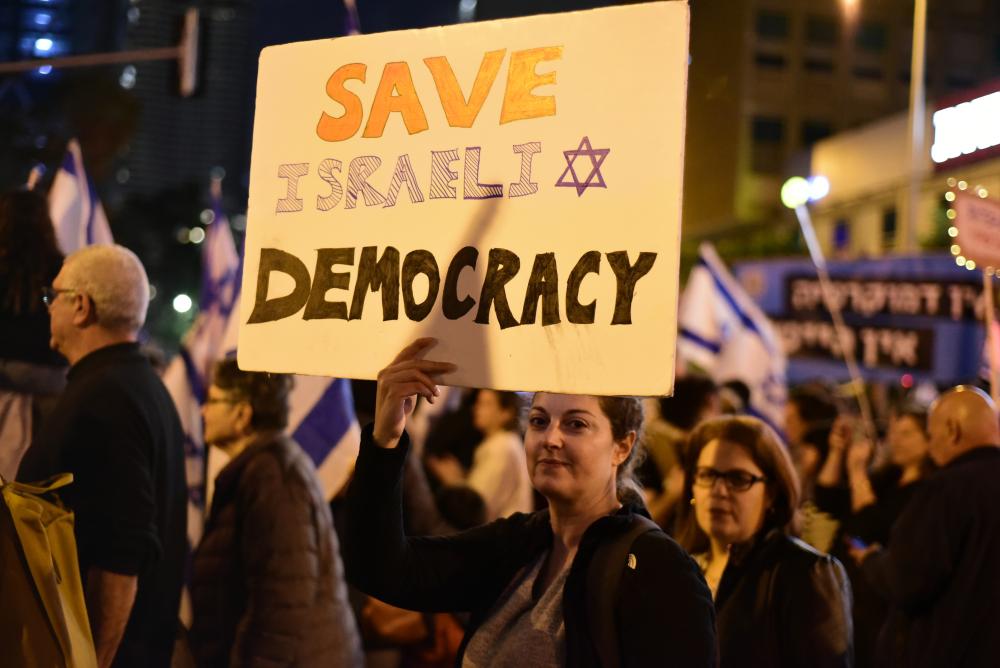
A February 2023 night demonstration in Tel Aviv called “Against Netanyahu’s Coup.” One in five Israelis have taken part in the protest movement. Shutterstock Photo by Avivi Aharon.
October 7 and the Israel-Hamas War
In October 2023, Israel suffered the largest single-day loss of civilian life — and the largest mass killing of Jews since the Holocaust — when it was attacked by Hamas, the terrorist group in control of the Gaza Strip. Twelve hundred people were killed and many more wounded in indiscriminate and brutal attacks that included sexual assault as a means of war. More than 250 people were kidnapped and taken to the Gaza Strip as hostages.
In October 2023, Israel suffered the largest single-day loss of civilian life — and the largest mass killing of Jews since the Holocaust — when it was attacked by Hamas, the terrorist group in control of the Gaza Strip.
After the attack, Prime Minister Netanyahu refused the offer of Yesh Atid’s leader, Yair Lapid, to form a unity government without the extremist Jewish Power and Religious Zionist parties. Benny Gantz’s National Unity Party agreed to join a war cabinet formed by the existing government but not including the extremist party’s ministers. After eight months Gantz withdrew from the war cabinet due to Netanyahu’s lack of a policy to end the war and his rejection of new elections despite widespread public opposition to the prime minister’s continued leadership following the October 7 attack.
The Israel Defense Forces (IDF) carried out a massive military response against Hamas, which still was able to continue attacking Israel with rocket barrages. The IDF carried out heavy bombing of civilian sites suspected of housing Hamas fighters and rocket launchers and there was sustained artillery and infantry strikes on urban centers. Hamas’s network of tunnels, at least 250 miles long, and use of civilian infrastructure as bases for operation, allowed its battalions to reconstitute in areas the IDF reported as cleared.
While most countries defended Israel’s right to self-defense, its war against Hamas has been widely criticized internationally for its widespread destruction, large number of civilians killed and wounded, the forced displacement of 2.3 million people and the resulting humanitarian crisis. As of August 2024, the total number of killed was reported to be nearly 40,000. This figure includes Hamas combatants, but a large number are civilians, including women and children. The International Court of Justice issued two rulings, one directing Israel to allow humanitarian relief and a second to end settlements in the West Bank. The International Criminal Court issued indictments of two Hamas leaders as well as of Israel’s prime minister and defense minister, in each case for acts of genocide and war crimes. The United States, Israel’s closest ally, has objected to both courts’ rulings.
The United States continued to supply weaponry to Israel for its defense as it and neighboring Arab countries also pursued cease fire agreements between Israel and Hamas. A brief cease fire in December 2023 resulted in the release of around 100 hostages in exchange for Palestinians held in detention. A broader cease fire for return of all remaining hostages and an end to the war has not been reached at this writing. Additional security threats to Israel remain with Hezbollah’s large army in Lebanon firing rockets and displacing 60,000 Israelis in Israel’s north; rockets fired by Houthi rebels in Yemen; and Iran carrying out a large air attack in April that was repulsed by the IDF and a US-led regional coalition.
Netanyahu’s refusal to take responsibility for the October 7 attack, his continuation of the war against Hamas and the government’s lack of success in gaining the return of Israeli and other hostages all created further political division in Israel.
Netanyahu’s refusal to take responsibility for the October 7 attack, his continuation of the war against Hamas and the government’s lack of success in gaining the return of Israeli and other hostages all created further political division in Israel. Increased attacks of Jewish settlers on Palestinians in the West Bank have also heightened tensions. The brutality of the October 7 attack by Hamas, however, reduced public polling support within Israel for a two-state solution to the Israel-Palestinian conflict.
There are ongoing protests against Netanyahu’s leadership, especially by hostage families and their supporters, as well as increasing opposition party demands for early elections. Recent and earlier demonstrations protesting the government’s attempt to control the judiciary have shown the vibrancy of civil society in the face of threats to Israel’s democracy. At the same time, the protests have been organized without substantial inclusion of the Arab Israeli community. As a result, the demonstrations do not reflect the many domestic efforts at promoting Jewish-Arab co-existence within Israel (see Resources).
The content on this page was last updated on .
